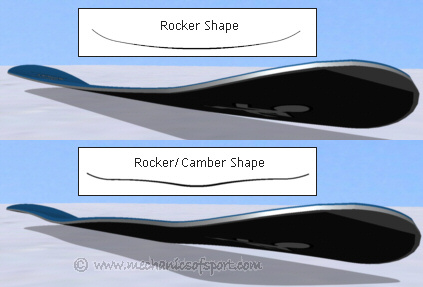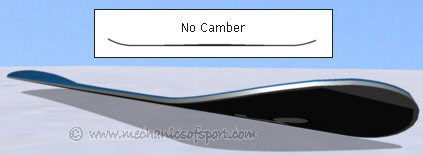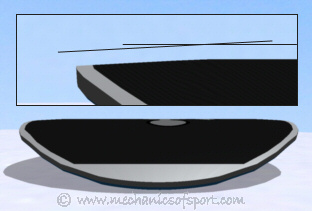Newer Snowboard Concepts
In the modern world, new design concepts for snowboards are appearing all the time. Here are some of the concepts that you will find on snowboards now, that are likely to become more and more common in the future.
Negative Camber

Often called a rocker. This is where the the traditional camber has been reversed, so that when the board is laid on a flat surface, the middle of the boards sits the lowest with the ends coming upwards. This shape makes it harder to catch an edge, as it's natural tendency is to push the edges up and away from the snow, which also makes snowboards easier to spin around. Because of this shape though, edge hold on harder snow is reduced considerably, which means that it is not so suitable for freeride boards. The shape can be modified to a rocker/camber shape though which naturally brings the ends of the boards off of the snow so that they don't catch, but has camber towards the tips so that they provide better edge hold when they are pushed on. As the negative camber concept is still quite new, it's not yet clear which shapes will become the most popular and quite what affect it will have on all the different types of snowboards. Negative camber is already commonly used on freestyle specific snowboards, although with shapes like the rocker/camber it might well start to influence other types of snowboard as well.
No Camber

This is similar to negative camber but instead of its shape pushing the edges away from the snow, the board will just lie completely flat on a flat surface. This shape means that although the edges will touch the snow along their length, they will not have that extra force trying to keep them there that a traditional camber provides. This makes a board that has more edge hold than a rocker board but less than a traditional camber board. This shape is currently being used on freestyle, and more powder orientated snowboards. For powder snowboards the flat section often lasts most of the board but with larger rocker shaped tips on the ends.
Edge Profiles
Instead of edges having traditional sidecut profiles along their length, a few different concepts are starting to be used on snowboards, generally intended to produce more edge grip by focusing edge pressure into a few smaller areas. The concepts vary from using several straight sections to make up an overall curve, to where the edge has a wavy shape so that some areas push into the snow more than others. The idea for these concepts came when manufacturers realised that pressure wasn't being distributed evenly along the edges, and there were a few points were most of the pressure was being transmitted. They decided to start experimenting with different shapes of edge, to see if edge hold could be improved, and these are the results so far. The concept is still quite new, but is already gaining popularity, and might be seen a lot more often in the future.

Beveled Edges

Beveled edges come from a practice that has long been used in snowboarding and skiing, but always used to be done by servicing, and was not manufactured into them. This is where the edges are detuned along the base of the snowboard (normally to about 2°) so that the base sits lower than the edges. The edges are often detuned by the same amount along the board, but sometimes the edges are detuned more in the middle of the board than the tips. Edge beveling is quite an effective way to keep good edge hold but yet make the edges harder to catch. This always used to be done by filing the bottom of the edges and the base area next to them away, but is now being manufactured into snowboards.
On to the Snowboard Bindings page.